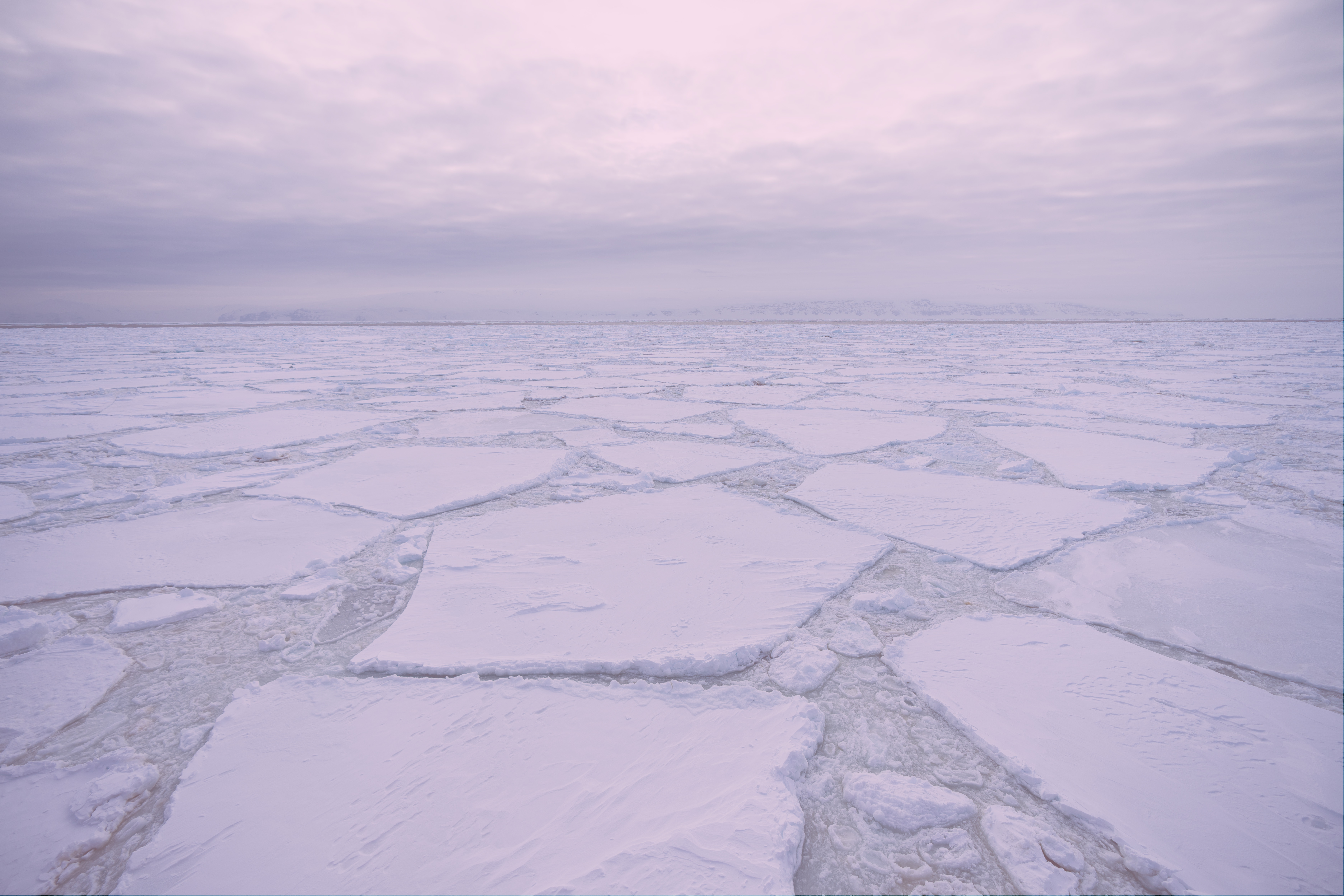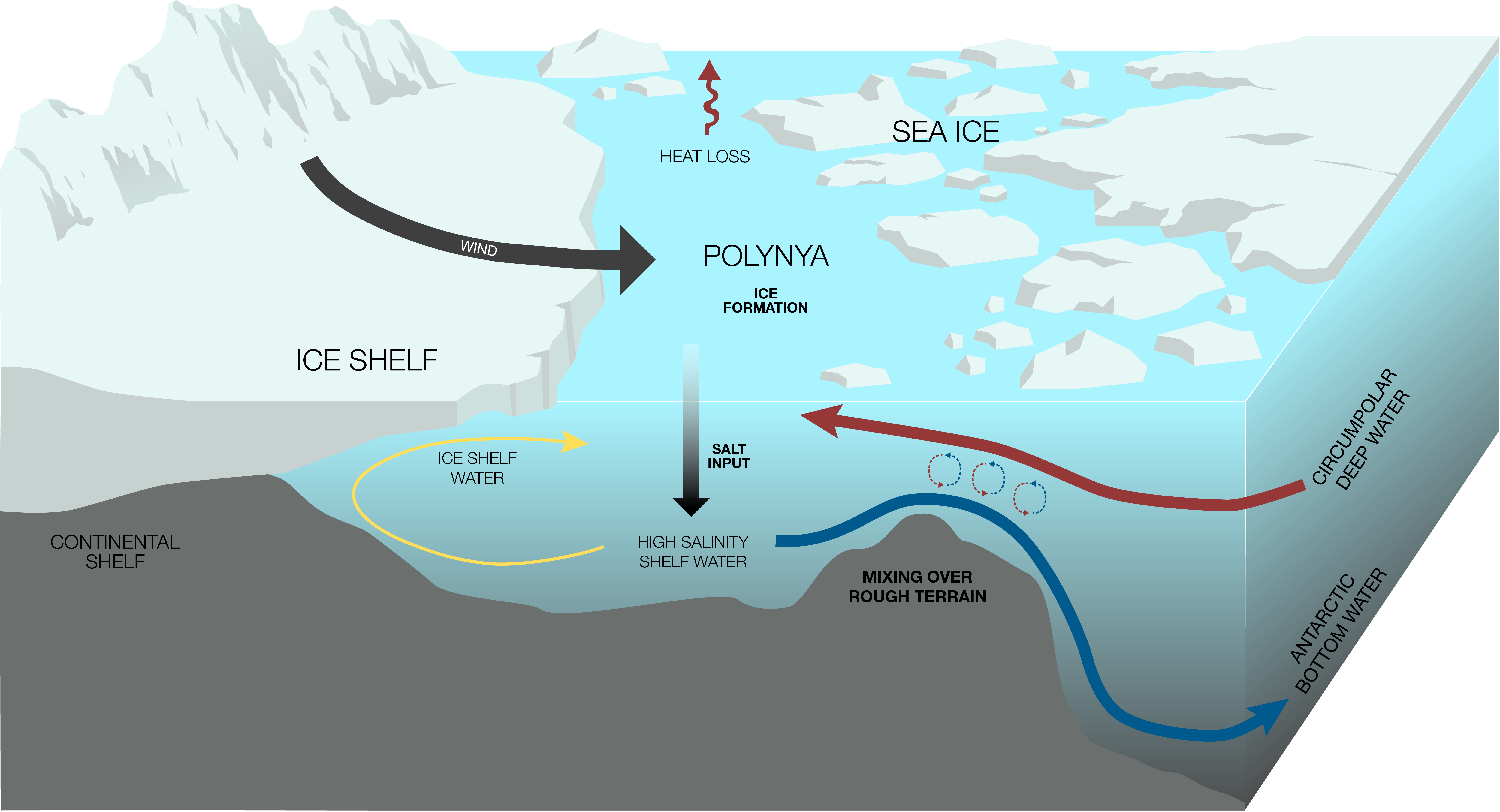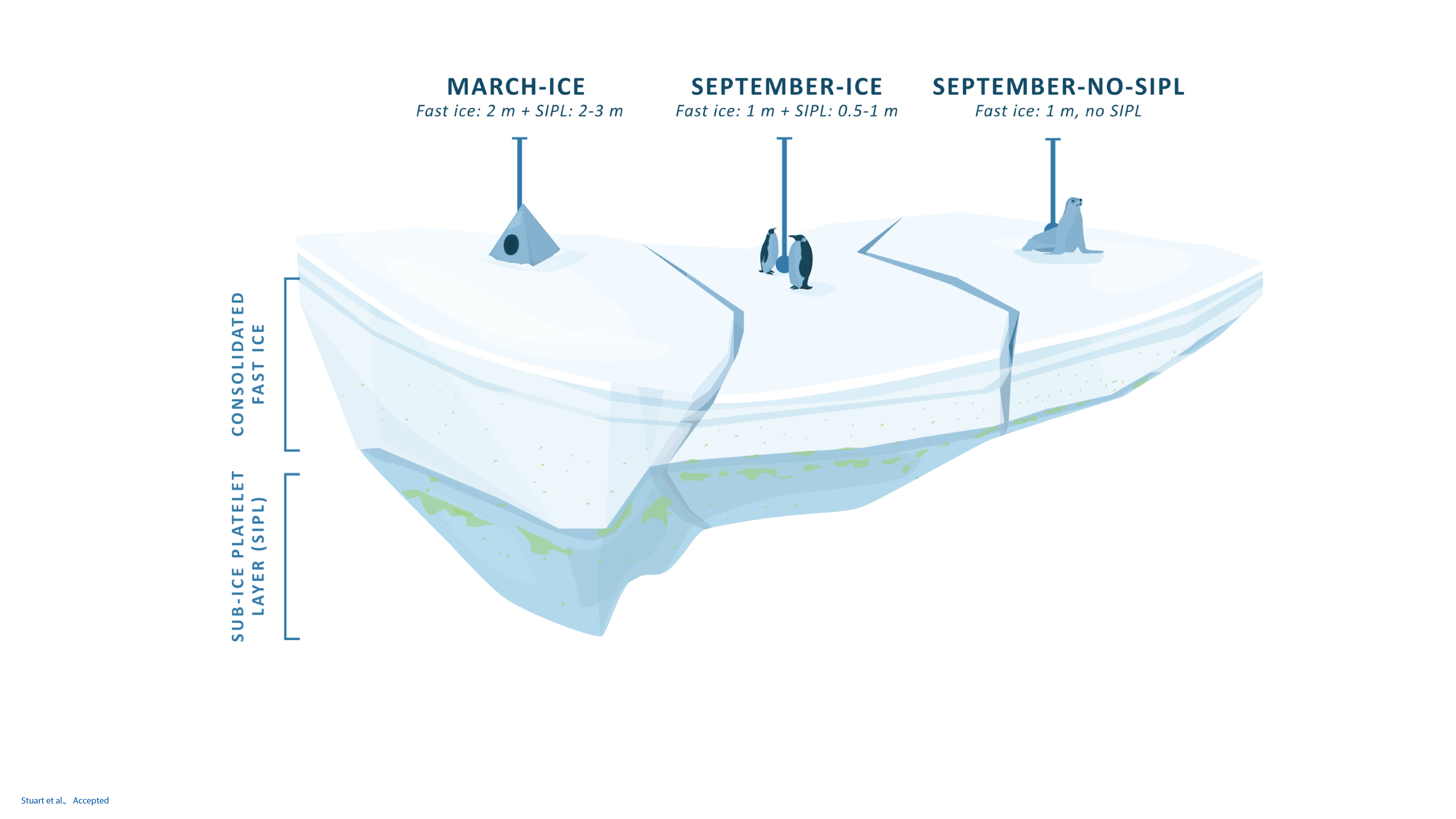
Declining Antarctic sea ice has cascading impacts
Changing Antarctic sea ice has global consequences. Since 2016, Antarctic sea ice has sharply and unexpectedly declined, likely due to combined effects of changes in the ocean, atmosphere, and winds. Understanding and monitoring changes in sea ice is crucial. This knowledge is needed to project future sea-ice behaviour and to understand the complex interactions between the ocean, atmosphere, ice, and ecosystems.
This summary
This summary aims to inform policy makers and scientific peers about sea-ice research conducted in the Ross Sea region by New Zealand’s Antarctic Science Platform (ASP).
This research synthesis:
- shares fundamental information about Antarctic sea ice and how it develops
- highlights the effects of a changing global climate on sea ice in the Ross Sea region
- provides critical baselines and new insights to understand how changing sea ice may impact Antarctica’s ice sheets, oceans and ecosystems in a warming world
- provides examples of how the research can be applied by domestic and international collaborators to advance science, environmental management and ecosystem resilience.
Key points
- Since 2016, Antarctic sea ice has declined unexpectedly and sharply. The first 3 years of loss was equivalent to 30 years of sea-ice loss in the Arctic. This dramatic decline is predominantly driven by changes in the Ross Sea region.
- Most of the sea-ice decline is observed in drift (pack) ice. In McMurdo Sound, no consistent decline has yet been detected in fast ice (ice connected to the coastline) – natural seasonal variability still dominates the signal here. But other parts of Antarctica are showing significant fast ice decline.
- Sea ice plays a major role in global climate and ecological systems, but models are currently unable to accurately predict sea-ice dynamics, including the Antarctic sea-ice decline in recent years.
- To understand changes in sea ice over time and to facilitate better modelling, researchers are using new techniques. High-resolution satellite imagery is used to more accurately characterise sea-ice types and floe dynamics and to measure the spatial extent of polynya (sea-ice factories). Snow and sea-ice measurements are becoming more accurate by integrating airborne and ground-based geophysics and radar.
- Climate change will likely reduce coastal polynya activity. These windswept, coastal ocean regions are sea-ice factories that have an important impact on global ocean currents and the transport of heat, salt, carbon, and nutrients.
- Researchers have established links between sea-ice characteristics, microalgae, and overwintering zooplankton. These links will allow connections between sea-ice changes and ocean food webs to be assessed.
About Antarctic sea ice
The growth and decline of Antarctic sea ice is one of the largest seasonal changes on Earth. Sea ice is the layer of frozen seawater covering the ocean surface at both poles. It grows every winter and contracts in summer. In Antarctica, the area covered by sea ice increases by approximately 16 million km², essentially doubling the size of the continent in winter.
Sea ice is broadly classified as first-year and multi-year ice, with further distinctions based on age, thickness, and formation. Sea ice can also be classified by its connection to land — fast ice is attached to the coastline, while drift ice moves north with winds and currents. Most Antarctic sea ice is first-year, drift ice.
Polynyas, which are areas of open water surrounded by sea ice, play a crucial role in producing Antarctic sea ice. These sea-ice factories form in regions where the ocean surface is regularly swept clear of sea ice by winds (coastal polynyas) or by ocean currents during winter (thermal polynyas). This clearing allows new ice to form where the ocean surface is then exposed to freezing temperatures.
Less sea ice affects the rate of global warming, ocean currents, and habitats
Snow-covered sea ice reflects up to 80% of incoming solar radiation into space, helping to keep the Earth cool. It also acts as a barrier, reducing the exchange of heat, greenhouse gases, and wind energy between the ocean and the atmosphere.
When sea ice forms, salty water sinks. This sinking contributes to the creation of Antarctic Bottom Water, the coldest, densest water mass that accounts for 30-40% of total ocean volume and drives global ocean circulation.
Sea ice protects ice shelves from wave action. This protection can slow down the rate of ice sheet melting and retreat, which in turn helps to slow down sea level rise.
Sea ice provides crucial habitats and breeding grounds for many marine species, including sea-ice algae, krill, fish, penguins and seals. Sea ice influences the amount and type of biological productivity in the Southern Ocean, which underpins the complex food web that ultimately supports seabirds, seals, and whales. Changes in sea ice will affect the distribution, abundance, and species composition of both pelagic (deep ocean) and benthic (seafloor) marine ecosystems.

Figure 1: Simplified diagram of the Antarctic ice and ocean environment.
Sea ice research
How Antarctic polynyas will respond to climate change is uncertain
A review by Antarctic Science Platform researchers published in Nature Reviews Earth & Environment examined the significance of Antarctic coastal polynyas in the Earth system, and how they interact with the atmosphere, sea ice, oceans, and biosphere. The location and strength of coastal polynyas varies over time, notably between glacial and interglacial periods, driven by changes in grounded ice sheet extent, atmospheric circulation, and ocean conditions. However, climate change is expected to reduce coastal polynya activity, but the exact impacts remain uncertain. The review calls for improved observational campaigns, including satellite-based measurements with intelligent algorithms. Better observations will improve models and deepen understanding of these important Antarctic features.

Figure 2: Ice types, formation time and characteristics. Adapted from Stuart et al. 2025
Contact information
Natalie Robinson
Associate Professor, Te Herenga Waka—Victoria University of Wellington
natalie.robinson@vuw.ac.nz
Wolfgang Rack
Professor, University of Canterbury
wolfgang.rack@canterbury.ac.nz
Inga Smith
Associate Professor, University of Otago
inga.smith@otago.ac.nz
Definitions
Sea ice: Frozen seawater, usually 1-2 meters thick. Antarctic sea ice extends north in the winter and retreats almost to the coastline every summer. Fast ice is attached to the coast and drift ice is not.
Platelet ice: A type of sea ice in Antarctic coastal regions, characterised by thin, disc-shaped ice crystals that can accumulate into sub-ice platelet layers beneath the sea ice or within the sea-ice structure.
Frazil ice: A specific type of ice formation, characterised by tiny, loose, needle-shaped ice crystals that are suspended in turbulent, supercooled water. Frazil ice is a crucial initial stage in the growth of Antarctic sea ice.
Polynyas: Sea-ice factories. Naturally occurring open water areas surrounded by sea ice, formed by wind and ocean currents pushing sea ice away from the coast, and exposing the ocean surface.
References
Brett GM, Price D, Rack W, Langhorne PJ (2021). Satellite altimetry detection of ice-shelf-influenced fast ice. The Cryosphere 15(8): 4099–4115. https://doi.org/10.5194/tc-15-4099-2021
Burada GK, McDonald A, Renwick J, Jolly B (2023). Delineating polynya area using active and passive microwave sensors for the Western Ross Sea sector of Antarctica. Remote Sensing 15(10): 2545. doi.org/10.3390/rs15102545
Crosta X, Kohfeld KE, Bostock HC, Chadwick M, Du Vivier A, Esper O, Etourneau J, Jones J, Leventer A, Müller J, Rhodes RH, Allen CS, Ghadi P, Lamping N, Lange CB, Lawler K-A, Lund D, Marzocchi A, Meissner KJ, Menviel L, Nair A, Patterson M, Pike J, Prebble JG, Riesselman C, Sadatzki H, Sime LC, Shukla SK, Thöle L, Vorrath M-E, Xiao W, Yang J (2022). Antarctic sea ice over the past 130 000 years – Part 1: A review of what proxy records tell us. Climate of the Past 18: 1729–1756. https://doi.org/10.5194/cp-18-1729-2022
Duffy GA, Montiel F, Purich A, Fraser CI (2024). Emerging long-term trends and interdecadal cycles in Antarctic polynyas. Proceedings of the National Academy of Sciences 121(11). doi.org/10.1073/pnas.2321595121
Farooq U, Rack W, McDonald A, Howell SEL (2023). Representation of sea ice regimes in the Western Ross Sea, Antarctica, based on satellite imagery and AMPS wind data. Climate Dynamics 60: 227–238. https://doi.org/10.1007/s00382-022-06319-9
Golledge NR, Keller ED, Gossart A, Malyarenko A, Bahamondes-Dominguez A, Krapp M, Jendersie S, Lowry DP, Alevropoulos-Borrill A, Notz D (2025). Antarctic coastal polynyas in the global climate system. Nature Reviews Earth & Environment 6: 126–139. doi.org/10.1038/s43017-024-00634-x
Haas C, Langhorne P J, Rack W, Leonard GH, Brett GM, Price D, Beckers JF, Gough AJ (2021). Airborne mapping of the sub-ice platelet layer under fast ice in McMurdo Sound, Antarctica. The Cryosphere 15: 247–264. doi.org/10.5194/tc-15-247-2021
Richter M E, Leonard G H, Smith IJ, Langhorne PJ, Parry M (2024). The interannual variability of Antarctic fast ice thickness in McMurdo Sound and connections to climate. Journal of Geophysical Research: Oceans 129. doi.org/10.1029/2023JC020134
Sidik SM (2024). Cold days bring fast ice. Eos 105. doi.org/10.1029/2024EO240585
Stuart J, Robinson N (2025). Antarctica’s sea ice is changing, and so is a vital part of the marine food web that lives within it. The Conversation. https://theconversation.com/antarcticas-sea-ice-is-changing-and-so-is-a-vital-part-of-the-marine-food-web-that-lives-within-it-255606
Stuart J, Robinson N, Stewart C, Smith KF, Pearman JK, Halfer S, Leonard G, Ryan KG (2025). A glimpse into the future: How the timing of sea ice formation influences associated microalgal communities. iScience 28(5). Doi.org/10.1016/j.isci.2025.112417